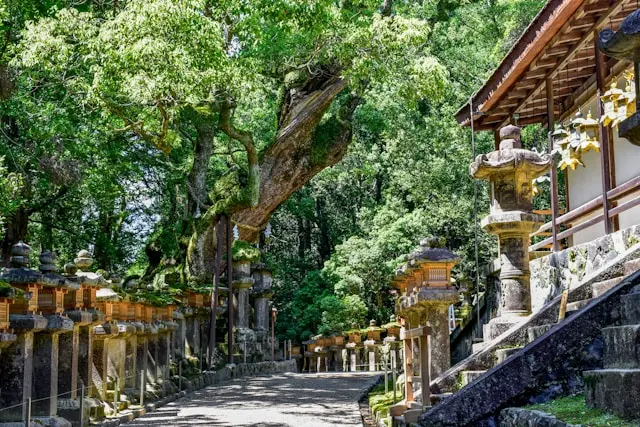
World Heritage Tour
Founded in 710 AD, Nara was Japan’s first capital and remains the city with the most World Heritage sites in the country. Over the past 1300 years, Nara has preserved many historic monuments and pristine natural landscapes, which have now been recognized as World Heritage Sites. Visiting these sites offers a journey into Japanese history, culture, traditional architecture, and deepens your understanding of the spiritual essence of Japan.
Nara Park
Opened on February 14, 1880, Nara Park is a vast park with a history of over 130 years, famous for its deer. The park includes three World Heritage sites: Kofuku-ji Temple, Todai-ji Temple, and Kasuga Taisha Shrine, along with the Nara National Museum, covering an area of 660 hectares. There are around 1,200 deer living in the park. In spring, the park is a famous cherry blossom spot, and in autumn, the park becomes a spectacular destination for viewing fall foliage. With its picturesque scenery across all four seasons, Nara Park hosts various traditional festivals throughout the year and is a popular destination for both Japanese students and international tourists.
Deer of Nara Park
Nara Park is home to about 1,200 deer, which have lived there for over 1,300 years. The people of Nara believe these deer are messengers of the gods. The deer are friendly and will even bow to people, ask tourists for deer crackers, and leisurely walk across roads where all vehicles must yield to them. These deer have become an iconic symbol of Nara, and various souvenirs featuring deer are popular among visitors.
Naramachi
Located near Nara Park, Naramachi is an historic district centered around the former site of Gango-ji Temple, a World Heritage site. This area covers about 48.3 hectares and was once a bustling commercial street from the 15th century, thriving with industries such as calligraphy brushes, ink, mosquito nets, fabric drying, quilts, knives, sake, and soy sauce. The area became a temple street, with a lively atmosphere, and over time, Naramachi’s traditional machiya (townhouse) streets have been preserved, making it a popular spot for visitors to experience the old-world charm of Nara.
Nishi no Kyo (West Kyoto)
Nishi no Kyo is located to the west of Heijo-kyo, the capital during the Nara period, and is known for preserving the ancient landscape of Nara. Upon arriving at the “Nishi no Kyo” station, you will feel as if you have entered a time tunnel. Walking from the World Heritage site, Yakushi-ji Temple, to Toshodai-ji Temple, you will pass by traditional farmhouses and expansive rice fields, with historical earthen walls and flowing rivers. The area offers a valuable experience of both Buddhist history and the original rural scenery of Nara, making it a perfect half-day trip for spiritual healing.
Ancient Festivals of Nara
Buddhism and traditional Shintoism have given rise to many moving festivals in Nara that are passed down from generation to generation. These festivals reflect the faith and spiritual origins of the Japanese people, intertwined with nature and the changing seasons. Continuing a festival tradition is a monumental task, and Nara has preserved the “Shuni-e (Water Drawing Festival)” for 1,263 years and the “Kasuga Wakamiya On-matsuri” for 879 years. Whether honoring gods, Buddha, or nature, Nara hosts representative festivals at various temples and shrines throughout the year.
Deep Immersion Experience in Nara
In addition to experiencing the historical monuments and natural beauty, visitors to Nara can engage in hands-on experiences of traditional Japanese culture, such as tea ceremonies, kimono wearing, calligraphy, zazen (seated meditation), and shrine worship rituals. You can also participate in traditional crafts like ink-making, brush-making, pottery, cedar carving, and making “oni-gawara” (demon tiles). For nature enthusiasts, Nara Park offers activities like giant tree observation.
Conclusion
After immersing yourself in Nara’s unique charm, you’ll likely find yourself returning to this captivating city.
